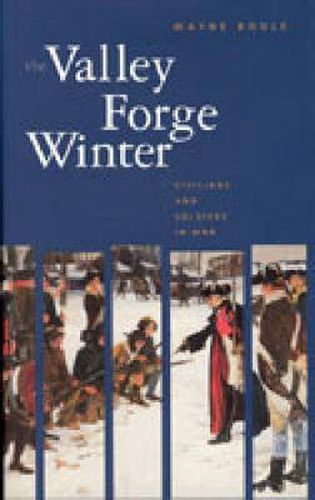Readings Newsletter
Become a Readings Member to make your shopping experience even easier.
Sign in or sign up for free!
You’re not far away from qualifying for FREE standard shipping within Australia
You’ve qualified for FREE standard shipping within Australia
The cart is loading…






Of the many dramatic episodes of the American Revolution, perhaps none is more steeped in legend than the Valley Forge winter. Paintings show Continentals huddled around campfires and Washington kneeling in the frozen woods, praying for his army’s deliverance. To this day schoolchildren are taught that Valley Forge was the turning point of the Revolution - the event that transformed a ragged group of soldiers into a fighting army. But was Valley Forge really the crucible of victory it has come to represent in American history? Now, two hundred and twenty-five years later, Wayne Bodle has written the first comprehensive history of the winter encampment of 1777-78. The traditional account portrays Valley Forge in the 1770s as a desolate wilderness far removed from civilian society. Washington’s army was forced to endure one of the coldest winters in memory with inadequate food and supplies, despite appeals to the Continental Congress. When the mild weather of spring finally arrived, the Prussian baron Friedrich von Steuben drilled the demoralized soldiers into a first-rate army that would go on to stunning victories at Monmouth and, eventually, at Yorktown. Bodle presents a very different picture of Valley Forge - one that revises both popular and scholarly perceptions. Far from being set in a wilderness, the Continental Army’s quarters were deliberately located in a settled area. And although there was a provisions crisis, Washington overstated the case in order to secure additional support. (A shrewd man, Washington mostly succeeded at keeping his army supplied with food, clothing, and munitions. Farmers from the interior provided food that ensured that the army didn’t starve.) As for Steuben’s role in training the soldiers, Bodle argues that it was not the decisive factor others have seen in the army’s later victories. The freshness of Bodle’s approach is that he offers a complete picture of events both inside and outside the camp boundaries. We see what happens when two armies descend on a diverse and divided community. Anything but stoically passive, the Continentals were effective agents on their own behalf and were actively engaged with their civilian hosts and British foes. The Valley Forge Winter is an example of the new military history at its best - a history that puts war back into its social context.
$9.00 standard shipping within Australia
FREE standard shipping within Australia for orders over $100.00
Express & International shipping calculated at checkout
Of the many dramatic episodes of the American Revolution, perhaps none is more steeped in legend than the Valley Forge winter. Paintings show Continentals huddled around campfires and Washington kneeling in the frozen woods, praying for his army’s deliverance. To this day schoolchildren are taught that Valley Forge was the turning point of the Revolution - the event that transformed a ragged group of soldiers into a fighting army. But was Valley Forge really the crucible of victory it has come to represent in American history? Now, two hundred and twenty-five years later, Wayne Bodle has written the first comprehensive history of the winter encampment of 1777-78. The traditional account portrays Valley Forge in the 1770s as a desolate wilderness far removed from civilian society. Washington’s army was forced to endure one of the coldest winters in memory with inadequate food and supplies, despite appeals to the Continental Congress. When the mild weather of spring finally arrived, the Prussian baron Friedrich von Steuben drilled the demoralized soldiers into a first-rate army that would go on to stunning victories at Monmouth and, eventually, at Yorktown. Bodle presents a very different picture of Valley Forge - one that revises both popular and scholarly perceptions. Far from being set in a wilderness, the Continental Army’s quarters were deliberately located in a settled area. And although there was a provisions crisis, Washington overstated the case in order to secure additional support. (A shrewd man, Washington mostly succeeded at keeping his army supplied with food, clothing, and munitions. Farmers from the interior provided food that ensured that the army didn’t starve.) As for Steuben’s role in training the soldiers, Bodle argues that it was not the decisive factor others have seen in the army’s later victories. The freshness of Bodle’s approach is that he offers a complete picture of events both inside and outside the camp boundaries. We see what happens when two armies descend on a diverse and divided community. Anything but stoically passive, the Continentals were effective agents on their own behalf and were actively engaged with their civilian hosts and British foes. The Valley Forge Winter is an example of the new military history at its best - a history that puts war back into its social context.